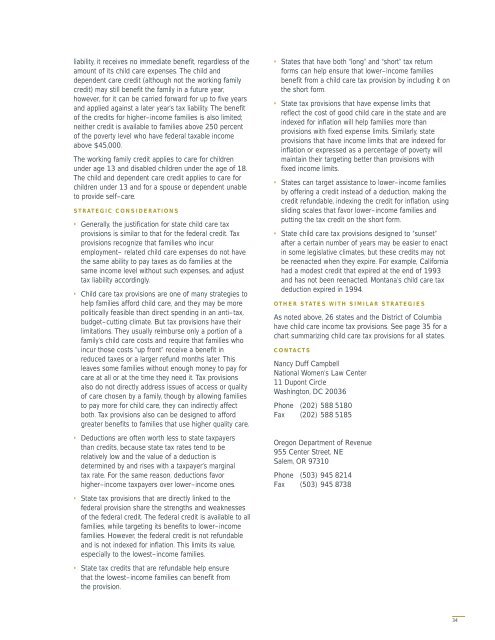Financing Child Care in the United States - Ewing Marion Kauffman ...
Financing Child Care in the United States - Ewing Marion Kauffman ...
Financing Child Care in the United States - Ewing Marion Kauffman ...
You also want an ePaper? Increase the reach of your titles
YUMPU automatically turns print PDFs into web optimized ePapers that Google loves.
liability, it receives no immediate benefit, regardless of <strong>the</strong><br />
amount of its child care expenses. The child and<br />
dependent care credit (although not <strong>the</strong> work<strong>in</strong>g family<br />
credit) may still benefit <strong>the</strong> family <strong>in</strong> a future year,<br />
however, for it can be carried forward for up to five years<br />
and applied aga<strong>in</strong>st a later year’s tax liability. The benefit<br />
of <strong>the</strong> credits for higher–<strong>in</strong>come families is also limited;<br />
nei<strong>the</strong>r credit is available to families above 250 percent<br />
of <strong>the</strong> poverty level who have federal taxable <strong>in</strong>come<br />
above $45,000.<br />
The work<strong>in</strong>g family credit applies to care for children<br />
under age 13 and disabled children under <strong>the</strong> age of 18.<br />
The child and dependent care credit applies to care for<br />
children under 13 and for a spouse or dependent unable<br />
to provide self–care.<br />
STRATEGIC CONSIDERATIONS<br />
• Generally, <strong>the</strong> justification for state child care tax<br />
provisions is similar to that for <strong>the</strong> federal credit. Tax<br />
provisions recognize that families who <strong>in</strong>cur<br />
employment– related child care expenses do not have<br />
<strong>the</strong> same ability to pay taxes as do families at <strong>the</strong><br />
same <strong>in</strong>come level without such expenses, and adjust<br />
tax liability accord<strong>in</strong>gly.<br />
• <strong>Child</strong> care tax provisions are one of many strategies to<br />
help families afford child care, and <strong>the</strong>y may be more<br />
politically feasible than direct spend<strong>in</strong>g <strong>in</strong> an anti–tax,<br />
budget–cutt<strong>in</strong>g climate. But tax provisions have <strong>the</strong>ir<br />
limitations. They usually reimburse only a portion of a<br />
family’s child care costs and require that families who<br />
<strong>in</strong>cur those costs “up front” receive a benefit <strong>in</strong><br />
reduced taxes or a larger refund months later. This<br />
leaves some families without enough money to pay for<br />
care at all or at <strong>the</strong> time <strong>the</strong>y need it. Tax provisions<br />
also do not directly address issues of access or quality<br />
of care chosen by a family, though by allow<strong>in</strong>g families<br />
to pay more for child care, <strong>the</strong>y can <strong>in</strong>directly affect<br />
both. Tax provisions also can be designed to afford<br />
greater benefits to families that use higher quality care.<br />
• Deductions are often worth less to state taxpayers<br />
than credits, because state tax rates tend to be<br />
relatively low and <strong>the</strong> value of a deduction is<br />
determ<strong>in</strong>ed by and rises with a taxpayer’s marg<strong>in</strong>al<br />
tax rate. For <strong>the</strong> same reason, deductions favor<br />
higher–<strong>in</strong>come taxpayers over lower–<strong>in</strong>come ones.<br />
• State tax provisions that are directly l<strong>in</strong>ked to <strong>the</strong><br />
federal provision share <strong>the</strong> strengths and weaknesses<br />
of <strong>the</strong> federal credit. The federal credit is available to all<br />
families, while target<strong>in</strong>g its benefits to lower–<strong>in</strong>come<br />
families. However, <strong>the</strong> federal credit is not refundable<br />
and is not <strong>in</strong>dexed for <strong>in</strong>flation. This limits its value,<br />
especially to <strong>the</strong> lowest–<strong>in</strong>come families.<br />
• State tax credits that are refundable help ensure<br />
that <strong>the</strong> lowest–<strong>in</strong>come families can benefit from<br />
<strong>the</strong> provision.<br />
• <strong>States</strong> that have both “long” and “short” tax return<br />
forms can help ensure that lower–<strong>in</strong>come families<br />
benefit from a child care tax provision by <strong>in</strong>clud<strong>in</strong>g it on<br />
<strong>the</strong> short form.<br />
• State tax provisions that have expense limits that<br />
reflect <strong>the</strong> cost of good child care <strong>in</strong> <strong>the</strong> state and are<br />
<strong>in</strong>dexed for <strong>in</strong>flation will help families more than<br />
provisions with fixed expense limits. Similarly, state<br />
provisions that have <strong>in</strong>come limits that are <strong>in</strong>dexed for<br />
<strong>in</strong>flation or expressed as a percentage of poverty will<br />
ma<strong>in</strong>ta<strong>in</strong> <strong>the</strong>ir target<strong>in</strong>g better than provisions with<br />
fixed <strong>in</strong>come limits.<br />
• <strong>States</strong> can target assistance to lower–<strong>in</strong>come families<br />
by offer<strong>in</strong>g a credit <strong>in</strong>stead of a deduction, mak<strong>in</strong>g <strong>the</strong><br />
credit refundable, <strong>in</strong>dex<strong>in</strong>g <strong>the</strong> credit for <strong>in</strong>flation, us<strong>in</strong>g<br />
slid<strong>in</strong>g scales that favor lower–<strong>in</strong>come families and<br />
putt<strong>in</strong>g <strong>the</strong> tax credit on <strong>the</strong> short form.<br />
• State child care tax provisions designed to “sunset”<br />
after a certa<strong>in</strong> number of years may be easier to enact<br />
<strong>in</strong> some legislative climates, but <strong>the</strong>se credits may not<br />
be reenacted when <strong>the</strong>y expire. For example, California<br />
had a modest credit that expired at <strong>the</strong> end of 1993<br />
and has not been reenacted. Montana’s child care tax<br />
deduction expired <strong>in</strong> 1994.<br />
OTHER STATES WITH SIMILAR STRATEGIES<br />
As noted above, 26 states and <strong>the</strong> District of Columbia<br />
have child care <strong>in</strong>come tax provisions. See page 35 for a<br />
chart summariz<strong>in</strong>g child care tax provisions for all states.<br />
CONTACTS<br />
Nancy Duff Campbell<br />
National Women’s Law Center<br />
11 Dupont Circle<br />
Wash<strong>in</strong>gton, DC 20036<br />
Phone (202) 588 5180<br />
Fax (202) 588 5185<br />
Oregon Department of Revenue<br />
955 Center Street, NE<br />
Salem, OR 97310<br />
Phone (503) 945 8214<br />
Fax (503) 945 8738<br />
34
















